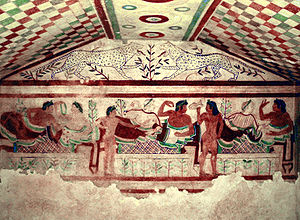
Tomb of the Leopards
Encyclopedia

Etruscan civilization
Etruscan civilization is the modern English name given to a civilization of ancient Italy in the area corresponding roughly to Tuscany. The ancient Romans called its creators the Tusci or Etrusci...
burial chamber so called for the confronted leopard
Leopard
The leopard , Panthera pardus, is a member of the Felidae family and the smallest of the four "big cats" in the genus Panthera, the other three being the tiger, lion, and jaguar. The leopard was once distributed across eastern and southern Asia and Africa, from Siberia to South Africa, but its...
s painted above a banquet scene
Symposium
In ancient Greece, the symposium was a drinking party. Literary works that describe or take place at a symposium include two Socratic dialogues, Plato's Symposium and Xenophon's Symposium, as well as a number of Greek poems such as the elegies of Theognis of Megara...
. The tomb is located within the Monterozzi necropolis and dates to around 480–450 BC. The painting is one of the best-preserved murals of Tarquinia
Tarquinia
Tarquinia, formerly Corneto and in Antiquity Tarquinii, is an ancient city in the province of Viterbo, Lazio, Italy.- History :Tarquinii is said to have been already a flourishing city when Demaratus of Corinth brought in Greek workmen...
, and is known for "its lively coloring, and its animated depictions rich with gestures."
The banqueters are "elegantly dressed" male-female couples attended by two nude boys carrying serving implements. The women are depicted as fair-skinned and the men as dark, in keeping with the gender conventions established in the Near East
Ancient Near East
The ancient Near East was the home of early civilizations within a region roughly corresponding to the modern Middle East: Mesopotamia , ancient Egypt, ancient Iran The ancient Near East was the home of early civilizations within a region roughly corresponding to the modern Middle East: Mesopotamia...
, Egypt
Art of Ancient Egypt
Ancient Egyptian art is the painting, sculpture, architecture and other arts produced by the civilization in the lower Nile Valley from 5000 BC to 300 AD. Ancient Egyptian art reached a high level in painting and sculpture, and was both highly stylized and symbolic...
and Archaic Greece. The arrangement of the three couples prefigures the triclinium
Triclinium
A triclinium is a formal dining room in a Roman building. The word is adopted from the Greek τρικλίνιον, triklinion, from τρι-, tri-, "three", and κλίνη, klinē, a sort of "couch" or rather chaise longue...
of Roman
Culture of ancient Rome
Ancient Roman culture existed throughout the almost 1200-year history of the civilization of Ancient Rome. The term refers to the culture of the Roman Republic, later the Roman Empire, which, at its peak, covered an area from Lowland Scotland and Morocco to the Euphrates.Life in ancient Rome...
dining. Musicians are pictured on the walls to the left and right of the banquet. On the right, a komos
Komos
The Komos was a ritualistic drunken procession performed by revelers in ancient Greece, whose participants were known as komasts. Its precise nature has been difficult to reconstruct from the diverse literary sources and evidence derived from vase painting....
of wreathed figures and musicians approaches the banquet; on the left, six musicians and giftbearers appear in a more stately procession.
The man on the far-right couch holds up an egg, symbol of regeneration, and other banqueters hold wreaths. The scene is usually taken to represent the deceased's funerary banquet, or a family meal that would be held on the anniversary of his death. It is presented as a celebration of life, while Etruscan banquet scenes in earlier tombs have a more somber character. The scene appears to take place outdoors, within slender trees and vegetation, perhaps under a canopy.
Although the figures are distinctly Etruscan, the artist of the central banquet draws on trends in Greek art and marks a transition from Archaic to Early Classical style
Severe style
The severe style, or Early Classic style, was the dominant idiom of Greek sculpture in the period ca. 490 to 450 BCE. It marks the breakdown of the canonical forms of archaic art and the transition to the greatly expanded vocabulary and expression of the classical moment of the late 5th century...
in Etruscan art. The processions on the left and right are more markedly Archaic and were executed by different artists.
The tomb was discovered in 1875. In the 1920s, D.H. Lawrence described the painting in his travel essays Sketches of Etruscan Places:
The walls of this little tomb are a dance of real delight. The room seems inhabited still by Etruscans of the sixth century before Christ, a vivid, life-accepting people, who must have lived with real fullness. On come the dancers and the music-players, moving in a broad frieze towards the front wall of the tomb, the wall facing us as we enter from the dark stairs, and where the banquet is going on in all its glory. … So that all is color, and we do not seem to be underground at all, but in some gay chamber of the past.
Artistically, the painting is regarded as less sophisticated and graceful than that found in the Tomb of the Bigas or the Tomb of the Triclinium.

